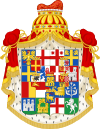Venetian army
The Venetian army was the army of the city-state of Venice, and later of the Republic of Venice and its dominions. During the Republic's early centuries, it was a force comprising an urban militia.
During Venice's imperial age in the Late Middle Ages and the Venetian expansion into mainland Italy (Terraferma) in the 15th century, its conflicts with the Duchy of Milan, the Papacy, and even France and Hungary, required the Venetian government to raise armies of tens of thousands. Given Venice's small population and the Venetians' traditional preoccupation with naval affairs, these armies were mostly composed of mercenaries (such as the Balkan stradioti or the companies of the various condottieri). Venetian noblemen served as commanders in or accompanied these armies as representatives of the Republic, but for most of subsequent Venetian history, their captain-generals were usually distinguished mercenary captains. A further problem for Venice was the need to station permanent garrisons in their overseas colonies. During the Ottoman–Venetian Wars, primacy was usually held by the commanders of the Venetian navy, and the army forces served without distinction as shipborne infantry, in the field, or as garrisons of fortresses. During these conflicts, the Venetian forces also incorporated a number of allied forces from other Italian states.
In the 16th century, the local militias were organized into the cernida system and a small permanent peacetime force of professional soldiers was created, to be augmented with mercenaries in wartime. During the 17th century, the Republic hired foreign regiments—usually from Germany or Switzerland—for service by treaty with foreign princes. By the early 18th century, the regimental system had been firmly established, with the Venetian units separated into italiani (recruited in Italy), oltramontani (Swiss, Germans, and other from 'beyond the mountains'), and oltramarini (recruited from the Republic's overseas possessions in the Balkans). This system lasted, with some changes, until the Fall of the Republic of Venice to Napoleon in 1797.
See also
[edit]Sources
[edit]- Birtachas, Stathis (2018). "Stradioti, Cappelletti, Compagnie or Milizie Greche: 'Greek' Mounted and Foot Troops in the Venetian State (Fifteenth to Eighteenth Centuries)". In Theotokis, Georgios; Yıldız, Aysel (eds.). A Military History of the Mediterranean Sea: Aspects of War, Diplomacy, and Military Elites. Leiden and Boston: Brill. pp. 325–346. doi:10.1163/9789004362048_017. ISBN 978-90-04-36204-8.
- Concina, Ennio (1972). Le Trionfanti et invittissime Armate Venete: Le Milizie della Serenissima dal XVI al XVIII secolo (in Italian). Venice: Filippi Editore.
- Lenci, Angiolo (2014). "Marignano 1515. L'esercito veneziano del primo Cinquecento". In Haudenschild, Roland (ed.). Marignano 1515-2015. Von der Schlacht zur Neutralität (in Italian). Lenzburg. pp. 191–202. ISBN 978-3856481476.
{{cite book}}: CS1 maint: location missing publisher (link) - Mallett, M. E.; Hale, J. R. (1984). The Military Organisation of a Renaissance State: Venice c. 1400 to 1617. Cambridge University Press. ISBN 978-0-521-24842-6.
- Mugnai, Bruno (2018). The Cretan War, 1645–1671: The Venetian-Ottoman Struggle in the Mediterranean. Warwick: Helion & Company. ISBN 978-1-911628-0-40.
- Prelli, Alberto (2012). Sotto le bandiere di San Marco –Le armate della Serenissima nel '600 (in Italian). Bassano del Grappa: itinera progetti. ISBN 978-88-88542-50-8.
- Prelli, Alberto; Mugnai, Bruno (2016). L'ultima vittoria della Serenissima: 1716 – L'assedio di Corfù (in Italian). Bassano del Grappa: itinera progetti. ISBN 978-88-88542-74-4.

